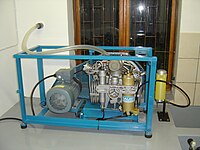
Photo from wikipedia
Summary There is no general rule in the literature to help choose a correct flow control device for any given case of turbomachinery applications. This suggests individual optimization of flow… Click to show full abstract
Summary There is no general rule in the literature to help choose a correct flow control device for any given case of turbomachinery applications. This suggests individual optimization of flow control devices for each specific case. The objective of this study is to prove experimentally the benefits of passive control methods in improving the compressor performance. This allows to reduce the fuel consumption, leading to energy saving and reduction of atmospheric pollution. Two features have been controlled in this study: flow separation over the blade surfaces and the secondary flow over the cascade endwalls. Vortex generator ribs are tested on the blade suction side for flow reattachment on the blade surfaces, and low-profile vortex generators are tested on the side walls of the compressor cascade against secondary flow losses. Different vortex generator designs are compared for total pressure recovery, flow turning, boundary layer characteristics, and pressure distributions over the endwalls. Copyright © 2016 John Wiley & Sons, Ltd.
Journal Title: International Journal of Energy Research
Year Published: 2017
Link to full text (if available)
Share on Social Media: Sign Up to like & get
recommendations!